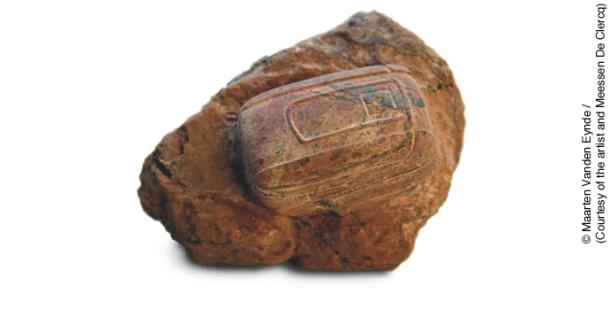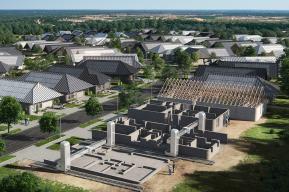مقال
الأعباء الثقيلة للمحيط التكنولوجي

في لمحة بصر بالمقاييس الجيولوجية، ظهر مجال جديد يستمر في النمو على وتيرة متسارعة، يناهز وزنه 30.000 مليار طن. يدعى هذا المجال «المحيط التكنولوجي» ويشمل كتلة من ثاني أكسيد الكربون المنبثقة عن النشاط الصناعي والمنبعثة في الجو – تمثّل وحدها ما يعادل 150.000 هرم من الأهرامات المصرية!
بقلم يان زالاسيوفيتز
يمكن وصف كوكب الأرض على أنه يتشكل من مجالات بيئية مختلفة. فهناك الغلاف الصخري المتكون من الطبقات الصخرية السفلى، والغلاف المائي من المساحات المغطاة بالمياه، والغلاف الجليدي ويضمّ المناطق القطبية وقمم الجبال الثلجية. أما الغلاف الجوي فهو الهواء الذي نتنفسه. ونحن أيضا جزء من المحيط الحيوي وننتمي الى الكائنات الحية المتواجدة في كوكب الأرض. وكانت كل هذه المجالات البيئية قائمة، بشكل أو بآخر، طوال فترة وجود الكوكب أي منذ حوالي 4،6 مليار سنة. وها أن برز في الفترة الأخيرة مجال بيئي جديد – ألا وهو المحيط التكنولوجي.
إن المحيط التكنولوجي بالمعنى الذي نعرفه، هو مفهوم تصوّره عالم الجيولوجيا المهندس الأمريكي بيتر هاف، وهو أستاذ فخري في جامعة ديوك بالولايات المتحدة. ومثل ما حدث مع مفهوم الأنثروبوسين (عصر هيمنة الإنسان)، يحظى مفهوم المحيط التكنولوجي باعتراف متزايد، وعلى سبيل المثال فهو يحتل مركزا محوريا في مشروع ضخم بعثته حديثا بيت الثقافة العالمية، المركز الدولي للفنون المعاصرة في برلين بألمانيا.
وكما حصل مع الأنثروبوسين، يثير مفهوم المحيط التكنولوجي جدلا بسبب الدور الذي ينسبه للبشر والقيود التي يفرضها عليه. فهو يوحي بأن حريتنا الجماعية في قيادة نظام كوكب الأرض هي أقل بكثير مما نتصوّر.
ويشمل المحيط التكنولوجي جميع المواد التكنولوجية التي أنتجها البشر، دون أن ينحصر فيها لأنه ليس مجرد مجموعة من الأجهزة التكنولوجية يتفاقم حجمها يوما بعد يوم، بل هو نظام في حد ذاته. ولتوضيح هذا التمييز الحاسم، يجدر مقارنته بمفهوم ثابت وهو المحيط الحيوي. ان عبارة "المحيط الحيوي" من صياغة العالم الجيولوجي النمساوي إدوارد سويس في القرن التاسع عشر، ثم قام العالم الروسي فلاديمير فيرنادسكي بتطويرها في القرن العشرين لتصبح مفهوما يدلّ ليس فقط على جملة الكائنات الحية المتواجدة على الأرض، بل ويشمل كذلك تفاعلها مع الهواء والماء والتربة التي تغذي الحياة العضوية، والشمس التي تمنحها جزءا هاما من طاقتها. لذلك يدلّ مفهوم المحيط الحيوي على ما أبعد من مجموع مكوّناته، لأنه مرتبط وثيق الارتباط بالمجالات البيئية الأخرى للكرة الأرضية، بالإضافة إلى ديناميته الذاتية وخصوصياته الظاهرة.
التلاعب بالطبيعة
والأمر كذلك بالنسبة للمحيط التكنولوجي. فهو لا يتكوّن فقط من الآلات، بل يشملنا أيضا نحن معشر البشر، اضافة الى النظم الاجتماعية والمهنية التي نستعملها في تفاعلنا مع التكنولوجيا: المصانع، والمدارس، والجامعات، والنقابات، والبنوك، والأحزاب السياسية والإنترنت. كما أنه يحتوي على الحيوانات الأليفة التي نقوم بتربيتها بأعداد هائلة لتغذيتنا، والنباتات التي نزرعها لتوفير قوتنا وقوت حيواناتنا، وأيضا الأراضي الزراعية التي تمّ تعديل حالتها الطبيعية بصفة جذرية لتحقيق هذه الأهداف.
كما يشمل المحيط التكنولوجي الطرق، والسكك الحديدية، والمطارات، والمناجم والمحاجر، وحقول النفط والغاز، والمدن، والمنشآت المائية وأحواض التخزين. وقد ولّد المحيط التكنولوجي كميات هائلة من النفايات - بدءا بمواقع دفنها وصولا الى تلوث الهواء والأراضي والمياه. من المؤكد أنه وجد في تاريخ البشرية شكل أوّلي للمحيط التكنولوجي، ولكنه لم يتمثل خلال فترة طويلة الّا في أجزاء معزولة ومتناثرة، دون أهمية كبرى على الكوكب. أما اليوم وقد تحوّل الى نظام عالمي مترابط، فهو يشكل تطورا جديدا وحاسما بالنسبة لكوكبنا.
ما هو حجم المحيط التكنولوجي؟ يمكن قياسه بصفة تقريبية باحتساب كتلة مكوّناته المادية المتمثلة في المدن وكميات التربة التي تم استخراجها ونقلها لبناء أسسها، وفي الأراضي الزراعية، والطرق والسكك الحديدية وما إلى ذلك. ويقدّر وزن المواد التي نستخدمها أو التي تم استخدامها ورميها بحوالي 30.000 طن لمجمل مساحة الأرض.
كما أن العناصر المادية المكوّنة للمحيط التكنولوجي في غاية التنوّع. لقد صنع أسلافنا في عهود تعود الى ملايين السنين، أدوات بسيطة مثل الفؤوس الحجرية. ولكن، اعتبارا من الثورة الصناعية، وبالخصوص منذ تصاعد سرعة النمو السكاني والتصنيع والعولمة في منتصف القرن العشرين، نشهد انتشارا مدهشا للآلات والأدوات المصنوعة، بشتى الأنواع. كما تتطوّر التكنولوجيا بسرعة متفاقمة ومستمرّة. ولم يشهد أسلافنا في مرحلة ما قبل الطور الصناعي، سوى تغييرات تكنولوجية قليلة من جيل إلى آخر. أما اليوم، على سبيل المثال، ففي غضون جيل بشري واحد، عمّ استخدام الهواتف الجوالة كل الفئات مهما كانت أعمارها.
أحافير المستقبل
وقد يساعدنا على بلورة الطبيعة الغريبة لهذة الظاهرة الجديدة التي اجتاحت عالمنا، اعتبار المنتجات التقنية - وفي مقدمتها الهواتف الجوالة - بمثابة الأحافير التقنية الشبيهة بالأحافير في المجال الجيولوجي، نظرا لأنها مصنوعة من مواد حيوية صلبة ولا تنحل بسهولة. وسوف تشكل أحافير المستقبل المكونة لطبقات الأنثروبوسين، أي عصر هيمنة الإنسان.
لا أحد يعرف عدد أصناف الأحافير التقنية حاليا، لكن حسب التقديرات، يحتمل أن يكون عددها قد تجاوز عدد أصناف الأحافير المعروفة. وفي ذلك وجه تشابه مع التنوّع التكنولوجي الحديث الذي فاق التنوّع البيولوجي الحديث. كما أن عدد أنواع الأحافير التقنية في تزايد مستمر، حيث أن سرعة التطور التكنولوجي فاقت بكثير سرعة التطور البيولوجي.
ان الطاقة الضرورية للمحيط الحيوي آتية حصريا من الشمس، أما المحيط التكنولوجي فهو يعتمد لا فقط على الطاقة الشمسية - وعلى الموارد المتجددة الأخرى مثل الطاقة الريحية - بل هو يبقى بالأساس معتمدا على الطاقة المستمدة من المحروقات مثل النفط والفحم والغاز. وفي الواقع، تتكون مصادر الطاقة غير المتجددة هذه من أشعة الشمس التي تجسّمت في أعماق الأرض طوال مئات الملايين من السنين، ويتمّ إهدارها في غضون بضعة قرون.
لقد استخدم البشر مصادر الطاقة مثل الطواحين المائية لآلاف السنين، لكن كميات الطاقة الضرورية الآن لتزويد المحيط التكنولوجي لا تترك أي مجال للمقارنة مع الماضي: إن كميات الطاقة التي استهلكها البشر منذ منتصف القرن العشرين تفوق الكميات التي تم استهلاكها خلال فترة الهولوسين أي على مدى أحد عشر ألف سنة.
تحت أكوام من النفايات
هناك نقطة اختلاف جوهرية بين المحيط التكنولوجي والمحيط الحيوي. لقد نجح المحيط الحيوي في إعادة تأهيل المواد التي تكونه، وذلك هو سبب استمراره على الأرض طوال مليارات السنين. أمّا المحيط التكنولوجي، فهو غير قادر على إعادة تأهيل المواد. هناك أمثلة صارخة تدل على هذا العجز منها جبال البلاستيك المتراكمة في البحار وعلى الشواطئ، في كل أنحاء العالم. وتوجد نفايات خفية عديمة اللون والرائحة مثل ثاني أكسيد الكربون الناجم عن المحروقات الأحفورية. لقد بلغت كتلة ثاني أكسيد الكربون المنبعثة في الجو جراء النشاط الصناعي حجما هائلا يقارب ألف مليار طن، أي ما يعادل حوالي 150.000 من الأهرامات المصرية. وفي حال عدم التحكم فيه، سوف يشكل هذا النمو السريع للنفايات تهديدا لبقاء المحيط التكنولوجي وحياة البشر.
المحيط التكنولوجي هو منبثق من المحيط الحيوي، وهو نظام معقد له ديناميكيته الخاصة. ومن أهم العوامل التي تسببت في ظهوره قدرة الجنس البشري على تكوين هياكل اجتماعية متطورة، وصنع الأدوات واستعمالها. ويوضح المهندس هاف أنه مع ذلك، ليس البشر هم الذين ابتكروا المحيط التكنولوجي ولا هم الذين يتحكمون في ادارته، بل البشر من بين مكونات هذا المحيط، مرغمون على السعي من أجل ثباته لأنه يضمن بقاء نسبة هامة من البشرية على قيد الحياة، بفضل ما يوفره من غذاء وسكن وموارد أخرى. وقد أدى تطور هذا المحيط الى نمو عدد سكان الأرض من بضعة عشرات الملايين - وهم أسلافنا الذين كانوا يقتاتون من الصيد والقطف - إلى 7،3 مليار نسمة. إن مجرد ابتكار تكنولوجي واحد - مثل الأسمدة الاصطناعية المنتجة حسب طريقة هابر-بوش - تمكّن من المحافظة على حياة حوالي نصف سكان المعمورة.
ولا يعود تطوّر المحيط التكنولوجي إلى إرادة الإنسان أو قدرته على التحكم فيه، وإنما إلى ظهور ابتكارات جديدة نافعة. وأصبحنا نشهد تطورا مشتركا بين النظم البشرية والنظم التكنولوجية.
ظروف عالمية متغيرة
وقد يجوز اعتبار المحيط التكنولوجي بمثابة عنصر طفيلي دخيل على المحيط الحيوي، أدى إلى زعزعة قابلية الأرض لإيواء الأحياء، مع عدد من العواقب الواضحة، منها: تسارع وتيرة انقراض أنواع النباتات والحيوانات، وتغيرات في المناخ وفي التركيبة الكيميائية للمحيطات وما ينجر عنها من أضرار على المجموعات البيولوجية الكائنة. وقد تؤدي هذه التغييرات بدورها إلى إفساد سيرورة المحيط الحيوي والإساءة بالسكان. والأفضل أن يحاول البشر توجيه تنمية المحيط التكنولوجي نحو مستقبل مستدام. علما وأن ليس لديه أي خيار سوى الإبقاء على سير المحيط التكنولوجي لأنه أصبح ضروريا للوجود.
إن تحديد هامش الحرية، في هذا السياق، من أجل العمل الاجتماعي-الاقتصادي والسياسي الفعال، هو أحد التحديات التي يطرحها علينا تطور المحيط التكنولوجي. والخطوة الأولى هنا هي في كيفية أن نفهم على نحو أفضل هذه المرحلة الجديدة غير العادية من تطور كوكبنا حيث لا يزال هناك الكثير مما ينبغي عمله.
الصور أعلاه
By Jan Zalasiewicz
The Earth that sustains us may be considered in terms of different spheres. There is the lithosphere, made up of the rocky foundations of our planet; the hydrosphere, representing our planet’s water; and the cryosphere, comprising the frozen polar regions and high mountains. The atmosphere is the air we breathe, and we are also part of the biosphere, made up of the Earth’s living organisms. These spheres have been in existence, in one form or another, for most, or all, of our planet’s 4.6-billion-year existence. Most recently, a new sphere has emerged – the technosphere.
The technosphere, in the sense that we understand it, is a concept that has been developed by the American geologist and engineer Peter Haff, Professor Emeritus at Duke University, in the United States. Like the Anthropocene, it is growing rapidly in recognition – having, for instance, been the focus of a recent major initiative of Haus der Kulturen der Welt (House of World Culture), the international centre for contemporary arts in Berlin, Germany.
Like the Anthropocene, the technosphere is controversial, not least because of the role – and constraints – it affords to humans. It suggests that we have far less freedom, collectively, to guide the Earth system, than we may think we have.
The technosphere encompasses all of the technological objects manufactured by humans, but that is only part of it. It is a system, and not just a growing collection of technological hardware. This distinction is crucial, and may be illustrated by comparison with the more established concept of the biosphere. Originally coined by the nineteenth-century Austrian geologist Eduard Suess, the term biosphere was developed as a concept by Russian scientist Vladimir Vernadsky in the twentieth century. He propounded that it was not just the mass of living things on Earth, but the combination of that mass with the air, water and soil that sustain organic life and the Sun’s energy that largely powers it. More than the sum of its parts, the biosphere interlinks and overlaps with other spheres of the Earth, while having its own dynamics and emergent properties.
Tampering with nature
The technosphere, similarly, comprises not just our machines, but us humans too, and the professional and social systems by which we interact with technology – factories, schools, universities, trade unions, banks, political parties, the internet. It also includes the domestic animals that we grow in enormous numbers to feed us, the crops that are cultivated to sustain both them and us, and the agricultural soils that are extensively modified from their natural state to carry out this task.
The technosphere also includes roads, railways, airports, mines and quarries, oil and gas fields, cities, engineered rivers and reservoirs. It has generated extraordinary amounts of waste – from landfill sites to the pollution of air, soil and water. A proto-technosphere of some kind has been present throughout human history, but for much of this time, it took the form of isolated, scattered patches that were of little planetary significance. It has now become a globally interconnected system – a new and important development on our planet.
How big is the technosphere? One crude measure is to make an assessment of the mass of its physical parts, from cities and the dug-over and bulldozed ground that makes up their foundations, to agricultural land, to roads and railways, etc. An order-of-magnitude estimate here came to some thirty trillion tons of material that we use, or have used and discarded, on this planet.
The physical parts of the technosphere are also very various. Simple tools like stone axes were made by our ancestors millions of years ago. But, there has been an enormous proliferation of different kinds of machines and manufactured objects since the Industrial Revolution, and especially since the Great Acceleration of population growth, industrialization and globalization of the mid-twentieth century. Technology, too, is evolving ever faster. Our pre-industrial ancestors saw little technological change from generation to generation. Now, in the space of little more than one human generation, mobile phones – to take but one example – have been introduced to mass public use and have gone through several generations.
Forming future fossils
One analogy here may help show the striking nature of this planetary newcomer. Technological objects, including mobile phones, may be considered technofossils geologically, because they are biologically-made constructs that are robust and resistant to decay; they will form future fossils, to characterize the strata of the Anthropocene.
Nobody knows how many different kinds of technofossils there are, but they already almost certainly exceed the number of fossil species known, while modern technodiversity, considered this way, also exceeds modern biological diversity. The number of technofossil species is continually increasing too, as technological evolution now far outpaces biological evolution.
While almost all of the biosphere’s energy comes from the Sun, some of the technosphere is powered by solar energy too – and other renewable resources such as wind-power, but most is powered by the burning of hydrocarbons including oil, coal and gas. These non-renewable energy sources in effect represent fossilized sunshine that has been amassed deep in the Earth over hundreds of millions of years, and that is now being expended in just a few centuries.
Humans have used power sources such as watermills for millennia, but the enormous burst of energy now needed to power the technosphere is on a completely different scale. One estimate suggests that humans have collectively expended more energy since the mid-twentieth century than in all of the preceding eleven millennia of the Holocene.
Inundated with waste
The technosphere, though, differs from the biosphere in one crucial respect. The biosphere is extremely good at recycling the material it is made of, and this facility has enabled it to persist on Earth for billions of years. The technosphere, by contrast, is poor at recycling. Some of the waste is all too obvious, like the plastics accumulating in the world’s oceans and on its shorelines. Other kinds, being colourless and odourless, are invisible to us, like the carbon dioxide from the burning of fossil fuels. The mass of industrially-emitted carbon dioxide in the atmosphere is now enormous – nearly one trillion tons, which is the equivalent of about 150,000 Egyptian Pyramids. This rapid growth in waste products, if unchecked, is a threat to the continued existence of the technosphere – and the humans that depend on it.
The technosphere is an offshoot of the biosphere and, like it, is a complex system with its own dynamics. The capacity of our species to form sophisticated social structures and to develop and work with tools were important factors in its emergence. However, Haff emphasizes that humans are not so much creators and directors of the technosphere, as components within it, and therefore constrained to act to keep it in existence – not least because the technosphere keeps most of the current human population alive, through the supplies of food, shelter and other resources that it provides. Its development has allowed the human population to grow from the few tens of millions that could be kept alive by the hunter-gatherer mode of life in which our species evolved, to the 7.3 billion that inhabit the planet today. Just one technological innovation – artificial fertilizers made using the Haber-Bosch process – keeps about half the human population alive.
The technosphere today is not evolving because it is being guided by some controlling human force, but because of the invention and emergence of useful technological novelties. There is now a kind of co-evolution of human and technological systems.
Altering planetary conditions
Currently, the technosphere might be regarded as parasitic on the biosphere, altering conditions of planetary habitability. Obvious consequences include greatly increased (and accelerating) rates of extinction of species of plants and animals, and changes to climate and ocean chemistry that are largely deleterious to existing biological communities. These changes can in turn damage both the functioning of the biosphere and human populations. Ideally, therefore, humans should try to help the technosphere develop into a form that is more sustainable in the long term. Nevertheless, humans collectively have no choice but to keep the technosphere operative – because it is now indispensable to our collective existence.
Working out the degrees of freedom, within this context, for effective socio-economic and political action, is one of the challenges that the evolving technosphere presents us with. A first step here is to more fully understand the workings of this extraordinary new phase in the evolution of our planet. Here, there is still much to do.
Jan Zalasiewicz
A British geologist of Polish origin, Jan Zalasiewicz is professor of Palaeobiology at the University of Leicester, United Kingdom. He has worked as a field geologist and palaeontologist for the British Geological Survey, and is Chair of the Anthropocene Working Group of the International Commission on Stratigraphy, since 2009.







